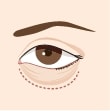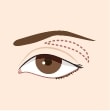What Is Blepharoplasty?
Eyelid surgery, also called blepharoplasty, is a procedure performed to rejuvenate aging changes of the upper and lower eyelids. Sun exposure, gravity, and even hereditary factors contribute to excess wrinkling and sagging skin of the upper and lower eyelids. Puffy bags under the eyes are common findings, as are droopy upper eyelids, a condition called eyelid ptosis. These changes often convey a tired appearance and can even interfere with full vision.
To reverse these changes, board-certified plastic surgeons like Dr. Brian Braithwaite and Dr. Lorri Cobbins can remove excess skin, fat, and even muscle to restore eyelid shape and contour. And because overcorrection can be as undesirable as no correction, our doctors address these changes in a very precise manner. Dr. Cobbins and Dr. Braithwaite can also repair droopy upper eyelids during the blepharoplasty procedure, correcting several problems in one surgery.
Like facelift surgery, blepharoplasty can be combined safely with other surgical procedures. When performed correctly, eyelid surgery can often produce dramatic results, providing patients with many years of more youthful eyes and a well-rested appearance.
Who Is a Good Candidate for Eyelid Surgery?
To determine if you are a good candidate for eyelid surgery, your doctor will review your health history and perform an examination during your consultation. Chronic conditions such as high blood pressure, dry eye syndrome, glaucoma, and thyroid abnormalities require thorough discussion. Your doctor will carefully examine your upper face, assessing brow position, skin laxity, fat deposits, and eyelid tone and position. To help understand your goals, we recommend that you bring photographs of your younger self to the consultation. We will also take preoperative photos during your visit. At the time of the consultation, your doctor will acquire an understanding of your goals and desires, as well as review available techniques and incision sites that can most effectively help you achieve your goals with beautiful, natural-looking results.
What Types of Eyelid Surgery Are Available?
You may have concerns related to your upper eyelids, your lower eyelids, or both. During your initial consultation, our plastic surgeons will review your concerns and develop a customized program to suit your needs. Patients have the option of:

Upper Eyelid Surgery
Upper eyelid blepharoplasty addresses the issues that can develop on the upper eyelids, including excess, droopy skin that can make you look tired, upset, or older than your age. If this effect becomes severe, the loose skin may even obstruct your vision.

Lower Blepharoplasty
Lower eyelid surgery corrects under-eye bags and wrinkles under the eyes. This procedure may be accompanied by dermal filler treatment to rejuvenate the appearance of the tear trough area in the event you have bags and dark circles or volume loss.

Double-Eyelid Surgery
Double-eyelid surgery, also known as Asian eyelid surgery, is a procedure designed to create a crease in the upper eyelid. Some individuals, many of them Asian, do not have a visible fold along the upper eyelid and prefer the aesthetics of this feature.
What Happens During the Eyelid Surgery Procedure?
“I just wanted to thank you again. I will always remember your unique style of practice – don’t change…I will definitely recommend you to anyone in need of your type of skills.”
What Should I Expect During Recovery from Eyelid Surgery?
Following eyelid surgery, we usually recommend eye drops or ointments to prevent dryness. Some temporary swelling and/or bruising may occur, but these symptoms should subside relatively quickly. Rarely described as anything more than mild, any potential discomfort can typically be alleviated with medication. Patients can usually wear contact lenses and makeup within two weeks when bruising and swelling resolve, and most individuals may drive and return to work once they discontinue narcotic pain medicine. Strenuous physical activity and/or intense exercise should be avoided for at least several weeks to ensure optimal healing.
How Long Do The Results From Eyelid Surgery Last?
The average lifespan of upper eyelid surgery ranges between five and seven years, though some patients see their results last much longer. Lower eyelid surgery, on the other hand, can often last for decades, preventing you from needing a secondary lift in the future. The full range of benefits and what you can expect from your procedure will be discussed with you when your comprehensive treatment plan is developed based on your unique needs.
What Complications Are Associated with Eyelid Surgery?
As with any surgical procedure, there is the risk of certain complications with blepharoplasty. However, when eyelid surgery is performed by a board-certified plastic surgeon, the chances of having something go wrong are significantly reduced. While most side effects are mild and temporary, some of the complications associated with eyelid surgery include:
- Irritated, dry, or itchy eyes
- Issues with opening and closing your eyes
- Scarring that is more noticeable than expected
- Discolored skin tone around the eyes
- Infection and bleeding
- Temporary blurred vision
- Temporary vision loss
These risks can be mitigated by a professional, accredited surgeon who is experienced with performing eyelid surgeries. At our Chicago practice, Dr. Braithwaite and Dr. Cobbins have gone through extensive plastic surgery training, accreditation, and education. They will take every precaution to maximize the safety of your eyelid surgery and will go over the possible risks with you prior to your surgery.
Can I Have an Eyelid Lift Without Surgery?
Non-surgical alternatives for an eyelid lift are available, depending on the particulars of your cosmetic goals. If you have excess skin, only surgery can trim away the unwanted tissue. However, if you have volume loss, fine lines and wrinkles, and textural concerns, cosmetic injectables and laser skin resurfacing can often provide dramatic improvement with little to no downtime. If we believe a conservative approach can deliver an optimal result, we will discuss with you the options that can help you refresh your eye area without the need for an operation.
How Much Does Blepharoplasty Cost?
The average price of eyelid surgery is $4,120*, and this number represents the surgeon’s fee alone. All blepharoplasty procedures conducted at our practice are customized to align with the unique needs and goals of the patient. For this reason, the cost of surgery will differ from individual to individual based on components such as whether treatment involves the upper eyelids, lower eyelids, or both. These factors will be thoroughly reviewed during the initial consultation, at which time a personalized quote of the total expense can be provided.
*According to the American Society of Plastic Surgeons
Is Eyelid Surgery Covered by Insurance?
Upper eyelid surgery may be partly covered by medical insurance if the excess skin is shown to obstruct your vision. Every person’s policy is different, and we recommend speaking with your insurance representative to determine your benefits coverage. We can also provide advice and guidance if, during your evaluation, we determine you qualify.
Additional Eyelid Surgery FAQs
What Are the Benefits of Upper Blepharoplasty?
The upper eyelid procedure can be personalized to:
- Remove extra skin responsible for upper eyelid sagging
- Diminish fat buildups and/or puffiness throughout the upper lids
- Reduce the appearance of upper eyelid wrinkles and creases
What Specific Concerns Can Lower Eyelid Surgery Help Resolve?
Based on each individual’s needs and goals, lower lid blepharoplasty can help treat the following cosmetic concerns:
- Lax, extra skin
- Visible bags
- Fat and/or muscle protrusion
- Wrinkles and crepey skin
Is Eyelid Surgery Able to Improve My Vision?
Depending on the extent of extra skin and fat present, the upper eyelids can sometimes droop low enough over the eyes that an individual experiences a reduced range of vision. In these instances, upper eyelid surgery can be employed to eliminate sagging, excess skin and fat accumulations from the upper lids, effectively improving one’s overall field of vision. At our practice, patients who have undergone blepharoplasty to resolve this “hooding” issue say they notice much better peripheral vision when performing various activities such as playing sports or driving a car.
Which Treatments Are Most Often Combined with Eyelid Surgery?
At The Aesthetic Institute of Chicago, many of our blepharoplasty patients choose to combine their procedure with facelift surgery, brow lift (forehead lift) surgery, and injectable fillers. Since blepharoplasty will only improve the appearance of the eye region, adjunctive treatments such as these can often help create a more comprehensive facial rejuvenation.
How Should I Clean My Eyelids After Blepharoplasty?
To help with the healing process and minimize the risk of infection, you will need to clean your eyelid area after blepharoplasty. Immediately following eyelid surgery, your eyes will likely go through a period of sensitivity, which can make cleaning the area uncomfortable at first. Our surgeons recommend patients wash the area around their eyes gently with a soft wash cloth or wipe. To be safe, our surgeons also recommend avoiding washing your face during showers for several days following surgery.
When Can I Wear Makeup After Eyelid Surgery?
Putting on makeup and using creams after eyelid surgery can cause skin sensitivity and discomfort. This is why our surgeons recommend patients wait a couple weeks before applying makeup to avoid the risk of infecting the area. Typically, people can begin applying makeup again after about two to three weeks.
For more information about eyelid surgery, or to schedule a consultation at our Chicago plastic surgery practice, please contact us via email or call (312) 361-8108 today.




